
RESEARCH
Summary for the social distribution of provisioning forest ecosystem services: Evidence and insights from Odisha, India
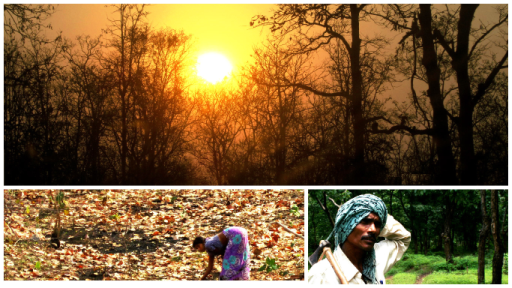
Most research linking ecosystems and the benefits local communities derive from them consider overall human well-being a linear derivative of ecosystem services, rarely paying attention to how ecosystem services are socially distributed. Additionally, most of this research tends to consider ecosystem services as purely a product of nature, thus obscuring the human contribution to their production.
As a result, such studies rarely elucidate the distributional dynamics of ecosystem services, which—as shown by an extensive body of political ecology research—are governed by over-arching access, power, cultural, gender, and caste structures. This study aims to analyse how these structures affect the distribution of ecosystem services across various social groups that strive to derive their benefits (either being direct consumers of such services or through the processing and sale of forest NTFPs).
To further shed light on how the distribution of ecosystem services across various social groups can take place on the micro scale, this study examines the Teen Mauza community forest management (CFM) initiative. This initiative was started in 2002 by the villagers of Akhupadar, Basantapur, and Lakhapada, by taking in their own hands a degraded patch of about 155 ha of reserve forest—falling under the jurisdiction of the forest department, adjoining Akhupadar village.
The CFM group currently consists of all resident households of Akhupadar (all of whom are scheduled tribes [ST]), and the general caste households of Basantapurand Lakhapada, in total forming a group of 78 households. Additionally, while access to the forest is available to those who are considered a part of the forest protection communities, many households are considered outsiders (including ‘newcomers’ who have recently migrated to these areas) and are excluded from using the ecosystem services rendered by the forest. Many of these people are landless and are heavily dependent on sharecropping and wage labour.
The lead author of the paper was embedded in Teen Mauza community for a period of 3 months to collect data through a range of methods, ranging from participant observation to structured household questionnaires, to understand the social processes governing the distribution of ecosystem services and costs.
The research revealed that bamboo provisioning services are heavily skewed against a group of scheduled caste households, who although are not part of the CFM initiative have traditionally been engaged in the sale of bamboo crafts. Additionally, while grazing benefits are enjoyed by a few households within the CFM community, non-CFM communities and a wealthy town-based herd owner were found to be using a much larger proportion of the grazing services. More significantly, the town-based herd owner accounted for a lion’s share of the grazing services, thus indicating that financial prowess and political clout greatly influence the distribution of grazing provisions in the forest.
While the ST community of Akhupadar (which makes up 20% of the Teen Mauza protection households) is heavily forest dependent and all ST households are engaged in the collection of either Siali leaves, mushrooms and tubers, less than 50% of the non-ST households engaged in the collection of NTFPs collect tubers and mushrooms. Additionally 80% of the women in ST households are involved in the collection of listed NTFP species, while only 4% of the general caste women are involved in NTFP collection. The low involvement of women in general caste households can be attributed to social control.
The position of the ST people in Teen Mauza is ambiguous. While they are able to make good use of its provisioning ecosystem services and are materially quite well-off, reliance on NTFPs confirms their lower status in the social hierarchy of Teen Mauza. The reverse of this dynamic is shown by the fact that while many of the general caste households of Teen Mauza are very poor, landless, and desperately need extra income, social values and stigmas associated with caste prevent them from making use of the forest's ecosystem services in the same way that the ST households do.
While this case study does indicate clear inequities in the distribution of ecosystem services, as indicated by the distribution of bamboo, grazing, and NTFP provisioning services, the results of this study are not meant to be generalised to characterise the interplay between ecosystem use and human wellbeing. Instead this paper aims to point out and empirically illustrate the principle that ecosystem services provisioning and distribution is a function of context-dependent social dynamics, calling on researchers in this field to carefully take these into account in future studies.
|
EDUCATION
Six students from Columbia University participated in a 6-week field study, as part of their Study Abroad Programme.
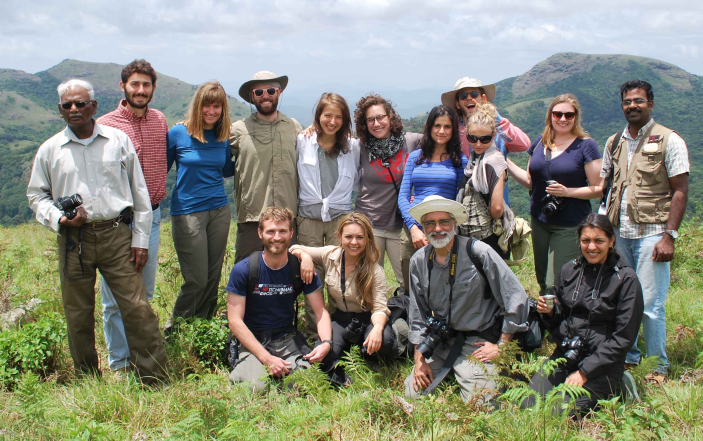
A Summer School in Water and Society was held at ATREE (co-organised with other ACCUWa faculty) IDRC Canada between June 15 and 26, 2015. The objective of the summer school was to build research capacity in interdisciplinary approaches to water issues in early career researchers, and to help researchers fill lacunae and bridge intellectual disciplinary and research-practice barriers. Of the 25 applicants that were chosen out of a strong pool of 105 applicants, 23 attended the school. Of these, 8 were natural scientists, 11 were social scientists, and 4 had interdisciplinary backgrounds. The school included four capacity-building components: common foundation and core concepts, interdisciplinary case studies, field trips, and working in interdisciplinary research groups. Over the first few days of the summer school, students were exposed to core concepts covering the main factors that impact water availability and water quality, as well as the interdisciplinarity and the value-laden nature of research. The final interdisciplinary theory session covered assessment methods – tools such as risk assessment, multi-criteria analyses or cost-benefit analyses that might draw on multiple disciplines to make decisions. Following this students were exposed to three case studies in water to help them understand how a problem-driven research question might actually be answered. Two day-long field trips were undertaken at Jakkur Lake and Sewage Treatment Plant (STP) near ATREE widely purported to be a “model lake”. Here they were exposed to the workings of STPs as well as the wider problem facing Bangalore’s lakes. The next visit was to the Aralmallige watershed. The students saw the weather station, one of the check dams we are monitoring, and a tank. For many students, this was their first exposure to actual watershed features.
|
The students also enjoyed a one-on-one interaction with Mr. Mallesh the President of the Aralmallige Gram Panchayat. The final field visit was to the TG Halli Reservoir. Here the students got to see first-hand, the problems of decline in inflows and water quality deterioration of the reservoir. Field visit to Peenya Industrial Area and Byramangala were conducted to increase awareness among students about the problems related to water pollution as a result of rapid urbanisation/industrialisation. Students were taken to the Vrishabhavathy stream which originates from Bangalore city and receives effluents from industrial and domestic sources. Though most students grew up in urban areas, many were seeing the scale of water pollution in cities for the first time. Students also visited the Byranmangla tank which receives wastewater from Bangalore city and is used by downstream farmers for irrigation. The students were taken around the peri urban villages to observe impact of urban wastewater flows. The final component involved students working in interdisciplinary teams to develop a problem driven research proposal. The 3-day team-work (assisted and facilitated by four faculty members) culminated in a 20 min proposal presentation on the last day. The 23 students were divided into six groups all of whom far exceeded our expectations.
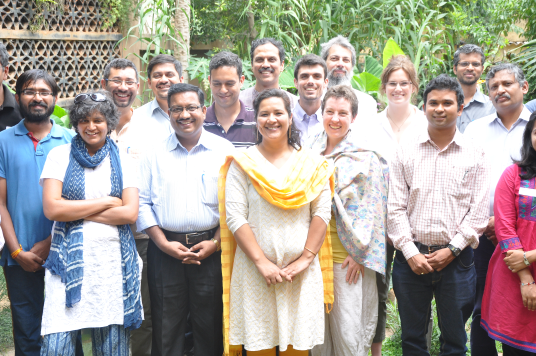
The Earthian’s ‘Learning for Life Programme—Forests, Biodiversity and People’ supported by WIPRO, conducted a 5-day workshop for educators at the Biligiri Community Conservation Centre at BRT Tiger Reserve from June 18 to 22, 2015. Focusing on biodiversity this year, the workshop provided nine teachers from four schools an opportunity to interact with researchers and incorporate ecological and conservation sciences into their everyday curriculum.
The Forum of Environmental Journalists in India (FEJI) announced its 2015 Fellows for the FEJI-ATREE Media Fellowship.
|
The Fellows—Radheshyam Jadav (Times of India) and Pankaj Sekhsaria (The Hindu Business Line) for print media; Padmaparna Ghosh (www.scroll.in) for Web/Online Media; and Shailesh Malode (All India Radio) for TV/Radio—attended a 2-day orientation and field visit organised by ATREE in Bangalore from June 22 to 24, 2015, before beginning their own travels and writing.
The updated ATREE online library catalogue (OPAC) was made live. This version includes several new features that will make searching and sharing easier. The ATREE library represents as exactly as the natural ecosystem in terms of its diversified information collection. It houses books under a range of categories such as philosophy, political science, sociology, anthropology, economics, law, science, mathematics, earth sciences and geology, climate change, plants, animals, natural history, women empowerment, landscaping and area planning, social problems and social services and others. The collection includes journals, an ePrints of articles, publications and audio-visual materials and maps of geographical indicators on India's environment. The fully automated library also provides access to JSTOR resources and to the University of Massachusetts online library. ATREE has also established collaboration with NIAS and Azim Premji University for resource sharing. It is now possible for ATREE folks to borrow books from the NIAS and APU libraries (and vice versa).
For the Doctoral Research Programme in Conservation Science and Sustainability Studies for the academic year 2015, around 100 applications were received from which 30 candidates were shortlisted for a written test and interview. 10 students were selected for the PhD Programme in Conservation Science and Sustainability Studies after clearing an entrance exam and a round of interviews. ATREE welcomed Anjan Katna, Anoop N.R., Anuja Date, Apoorva Kulkarni, Chitra Lakhera, Jyoti Nair, Kadambari Deshpande, Nita Shashidharan, Rinan Shah, and Roshni Kutty. They spent the first week of August orientating and attending the ATREE work seminar, following which they commenced coursework on August 10.
|
|
ATREE's Academy for Conservation Science and Sustainability Studies announced its Field Course in Conservation Science to be held between July 13 and 23, 2015. The course will focus on conservation issues at the regional level but with a global perspective.
Rajkamal Goswami was awarded his PhD from Manipal University for his study Forest cover, hunting, and animal abundances across state and community forests of Meghalaya, India.
NEW
People
We welcome and introduce Revathi J. (Field Coordinator), Venkitachalam (Research Scholar), Nagendra P. (Research Assistant), Anu Radhakrishnan (Research Associate), Abhishek Samrat (Consultant), Vanaraj Ganapathy (Programme Associate), and K. Veeramani (Research Associate).
Publications
Bharath Sundaram's Ph.D. work under the guidance of Ankila Hiremath was published in NeoBiota. Factors influencing the local scale colonisation and change in density of a widespread invasive plant species, Lantana camara, in South India. NeoBiota 25: 27-46. doi:10.3897/neobiota.25.8354.
Siddappa Setty, R. 2015. The sustainability of soapberry (Sapindus laurifolia Vahl) fruit harvest by the Soliga community in South India. In: Ecological sustainability for non-timber forest products: dynamics and case studies of harvesting (eds. Shackleton, C., A. Pandey, and T. Ticktin). Pp. 126–143. London: Earthscan. ISBN: 9780415728591.
Srinivasan, V., S. Thompson, K. Madhyastha, G. Penny, K. Jeremiah, and S. Lele. 2015. Why is the Arkavathy river drying? A multiple-hypothesis approach in a data-scarce region. Hydrology and Earth System Sciences 19(4): 1905–1917. doi:10.5194/hess-19-1905-2015.
Thomas, B.K., P. Jamwal, S. Lele, and V. Srinivasan. 2014. Thinking about urban resilience: the case of water scarcity and wastewater reuse in Bengaluru. Urban Resilience: Proceedings of the Colloquium, Bengaluru: Public Affairs Centre. September 27, 2014. Pp. 34-37. ISBN: 9788188816378.
|
Hebbar, P., K.V. Gururaja, and G. Ravikanth. 2015. Morphology, natural history and molecular identification of tadpoles of three endemic frog species of Nyctibatrachus Boulenger, 1882 (Anura: Nyctibatrachidae) from Central Western Ghats, India. Journal of Natural History. 1-15. http://dx.doi.org/10.1080/00222933.2015.1034212.
Lakerveld, R.P., S. Lele, T.A. Crane, K.P.J. Fortuin, and O. Springate-Baginski. 2015. The social distribution of provisioning forest ecosystem services: evidence and insights from Odisha, India. Ecosystem Services 14: 56-66.
Naveena, N.L., S. Subramanya, and R. Siddappa Setty. 2015. Diversity and distribution of stored grain insects among the Soliga tribal settlements of Biligirirangana Hills, Karnataka, India. Journal of Stored Product Research 62: 84–92. doi:10.1016/j.jspr.2015.04.002.
Thriveni H.N., G. Ravikanth, R. Vasudeva, K.N. Ganeshaiah, and R. Uma Shaanker. 2015. Camptothecine and methoxy camptothecine from callus cultures of Miquelia dentata Bedd.— A rare plant of the Western Ghats of India. Indian Journal of Biotechnology 14: 123-126.
T. Ganesh and Vikram Aditya's article on the first camera trap records of the Indian crested porcupine from Papikonda National Park appeared in the May 2015 edition of Small Mammal Mail. Aditya, V. and T. Ganesh. 2015. First camera trap records of Indian Crested Porcupine, Hystrix indica Kerr, 1792 from Papikonda National Park, Andhra Pradesh. Small Mammal Mail - Bi-Annual Newsletter of CCINSA & RISCINSA 4: 7(1): 4-5.
Das, A., H. Nagendra, M. Anand, and M. Bunyan. Topographic and bioclimatic determinants of the occurrence of forest and grassland in tropical montane forest-grassland mosaics of the Western Ghats, India. PLOS ONE 10(6): e0130566. doi:10.1371/journal.pone.0130566.
Krishnan, S., C.L. Pastore, and S. Temple (eds.). 2015. Unruly environments RCC Perspectives 3. http://www.environmentandsociety.org/perspectives/2015/3/unruly-environments.
|
Krishnan, S. 2015. Landscape, labor, and label: the Second World War, pastoralist amelioration, and pastoral conservation in the Nilgiris, South India (1929–1945). International Labor and Working-Class History 87: 92-110. doi:10.1017/S0147547915000046.
In the news
Demystifying Arkavathy fiasco. Bangalore Mirror. April 24, 2015.
Vrishabhavati sewage treatment plant inefficient, says study. The Hindu. April 30, 2015.
Red sanders: violent forest policing. Deccan Herald. May 4, 2015.
Indian scientists spot rare plant with potential anti-cancer properties. Business Standard. May 14, 2015.
New species of frog, fish found in Western Ghats. The Hindu. May 29, 2015.
Organic paradox. Down to Earth. June 15, 2015.
Son Gharial Sanctuary will be instrumented with water level recorders. Dainik Bhaskar. Hindi edition, Madhya Pradesh.
Citizens for the city. Citizens chip in to save lakes; Centre to make it mass model. The Times of India. June 30, 2015. Radheshyam Jadav (Times of India); FEJI-ATREE Media Fellow 2015.
Talks@ATREE
S.P. Vijayakumar and Kartik Shanker. Born in the mountains: the role of glaciations, gradients and geology in the diversification of an evolutionary radiation in the Western Ghats escarpment. April 6, 2015.
Sunil K. Choudhary. Arsenic and fluoride contamination in groundwater sources of Bhagalpur district, Bihar. April 13, 2015.
David W. Cash. Strategic action linking science and policy: multi-level and interdisciplinary solutions for complex problems. April 23, 2015.
Johny Stephen. Fishing for space: socio-spatial relations of Indian trawl fishers in the Palk Bay, in the context of trans-boundary fishing. May 18, 2015.
|
|
Sunayana Ganguly. Deliberation and advocacy in India: a comparative perspective. May 20, 2015.
Sharad Lele. Lecture to Columbia University Students on Forest Issues. June 5, 2015.
Recognitions
G. Ravikanth was awarded the Erasmus Mundus Action II - Scholarship by the Networking and Mobility Actions for Sustainable Technology and Environment (NAMASTE) Consortium in India coordinated by the Georg-August-Universitat Gottingen, Germany. The grant enabled him to visit Uppsala University for a month in May 2015. During this period, he was involved in developing a joint paper as well as in discussing projects of mutual interest.
Dr. Bawa was elected as a Fellow of the Royal Society, London—the oldest and one of the most prestigious science academies of the world, on April 30, 2015. He was inducted to the Society at a ceremony in London on July 10, 2015.
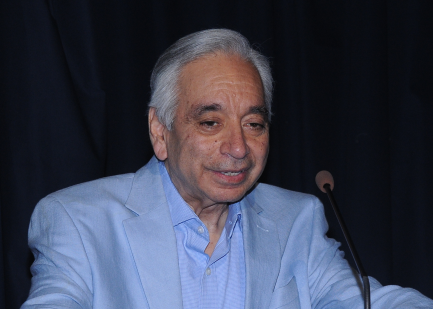
Student awards
Chandrima Home was awarded the Department of Science and Technology’s Woman Scientist ‘A’ Award. This award covers Chandrima’s fellowship for three years, as well as provides for some field expenses and contingencies.
Ovee Thorat was awarded the Carl Zeiss Wildlife Conservation Award for 2015, on the April 10 by Suresh Prabhu, the Union Minister of Railways in a ceremony in New Delhi. Ovee was nominated for her work in Ranthambhore (as part of Tiger Watch), Mumbai (education and awareness related activities), and her current work in the Banni grasslands.
|
Invited lectures and workshops
Priti Gururaj was interviewed for her research on the frogs of the Western Ghats. The article has been published in Saudi Arabia newspaper—the National. The interview contains inputs from Priti Gururaj, Dr. Kartik Shanker, IISc, and Dr. Vijayakumar, NCBS. http://www.audiomatic.in/frog-spotting-in-the-western-ghats.html.
Lele, S. From environmental economics to ecological economics to an interdisciplinary environmental enquiry. Presented at a seminar at the Department of Agricultural Economics, Tamil Nadu Agricultural University Coimbatore. April 7, 2015.
Lele, S. Panel discussion on Bangalore water problem. Panelist. Green Path, Bangalore. June 17, 2015.
Lele, S. Water literacy to meet the challenge of water governance. Keynote address at the 15th All India People's Science Congress. BGVS Karnataka & KRVP Bangalore. May 22, 2015.
Lele, S. Workshop on Enhancing NTFP-based Livelihoods in Community Forest Resource Areas. Kalpavriksh, Vasundhara, and ATREE. Bhubaneshwar. April 8-9, 2015.
Lele, S. Water management: challenges and opportunities. Plenary panel on the XVth World Water Congress. Edinburgh. May 27, 2015.
Thomas, B.K., M. Eswar, S.D. Kenchaigol, V. Srinivasan, and S. Lele. 2015. Enhancing resilience or furthering vulnerability? Responses to water stress in an urbanizing basin in southern India. Presented a draft paper from the Arkavathy basin component of the ACCUWa project at the ICARUS Fourth Global Meeting held at University of Illinois at Urbana-Champaign, USA. May 7-10, 2015.
|
Grants Received
ATREE received a USD 55,000 grant from Earth Institute Center for Environmental Sustainability, Columbia University to conduct a field ecology study abroad programme.
ATREE received a USD 300,000 grant from the Barr Foundation of which USD 200,000 is an endowment support for climate resilient livelihood and biodiversity conservation in the Eastern Himalaya.

|
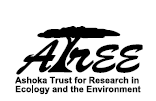 www.atree.org
www.atree.org
|
Head Office
Bengaluru
Royal Enclave, Sriramapura
Jakkur Post, Bengaluru 560 064
Tel: +91-80-23635555
Fax: +91-80-23530070
Regional offices
Eastern Himalayas
Khangsar House
Above Brahmakumari, Development Area
Gangtok 737101
Tel: +91-3592-206 403
New Delhi
C-86, 2nd floor,
B K Dutt Colony,
New Delhi 110003
Tel no: 011-24603134
Governing Board
Dr. Kamaljit S. Bawa (Chairman)
Dr. K. N. Ganeshaiah
Dr. R. Uma Shaanker
Mr. Darshan Shankar
Ms. Rohini Nilekani
Dr. Surinder M. Sehgal
Ms. Seema Paul
Ms. Pheroza J. Godrej
Dr. K. S. Jagadish
Mr. A. N. Singh
Dr. S. Natesh
Dr. Ganesan Balachander (ex-officio)
Dr. Bejoy K Thomas (faculty representative)
Executive Committee
Dr. Ganesan Balachander (Chair)
Dr. Ankila Hiremath
Dr. Abi Tamim Vanak
Dr. Sharachchandra Lele (ex officio)
Dr. Jagdish Krishnaswamy (ex officio)
Dr. Nitin Rai (ex officio)
|
Advisory Board
Pl note: * will also serve on the Faculty Advisory Committee
* Dr. Vijay Raghavan, Director, National Centre for Biological Sciences, Bengaluru
Dr. Raghavendra Gadagkar, INSA SN Bose Research Professor and JC Bose National
Fellow, Centre for Ecological Sciences, Bengaluru
* Dr. Amita Baviskar, Associate Professor, Institute of Economic Growth, Delhi
* Dr. Navroz K. Dubash, Senior Fellow, Centre for Policy Research, New Delhi
* Dr. Gita Sen, Professor, Centre for Public Policy, Indian Institute of Management, Bengaluru
Mr. Raj Khoshoo, Senior Vice President, Siemens PLM, CA, USA
Ms. Kalpana Sharma, independent journalist, Mumbai
Dr. Ravi Chopra, Director, People’s Science Institute, Dehradun, Uttarakhand
* Dr. S. P. Singh, Former Vice Chancellor,
Advisor, State Planning Commission,
Government of Uttarakhand, Dehradun,
Uttarakhand
Convenors and Programme Leaders
Dr. Jagdish Krishnaswamy,
Ecosystem Services and Human Well-being
and Convenor, Suri Sehgal Centre for
Biodiversity and Conservation
Dr. Sharachchandra Lele,
Forests and Governance and Convenor,
Centre for Environment and Development
Dr. Priyadarsanan Dharma Rajan
and Dr. Ankila Hiremath,
Ecosystems and Global Change
Dr. Shrinivas Badiger
Land Water and Livelihoods
Academy
Dr. Nitin Rai,
Convenor, Academy for Conservation
Science and Sustainability Studies
This newsletter has been put together from reports by ATREE folk. Design by Shiva Subramanya Editing by Aditya Harikrishnan, and Ganesan Balachander.
|
|

